Overview of species and varieties of daffodils
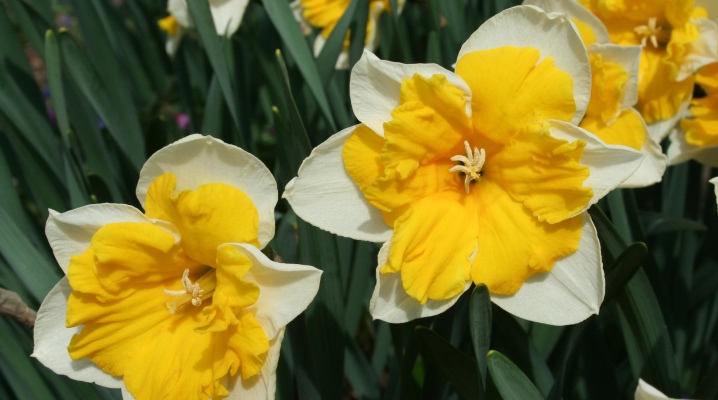
With the onset of the first spring heat, primroses bloom on the flower beds. Among them, daffodils attract attention with their elegance, bright color and rich aroma. Although their flowering is short-lived, they enjoy well-deserved love and popularity among flower growers.
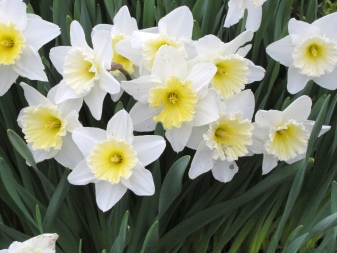
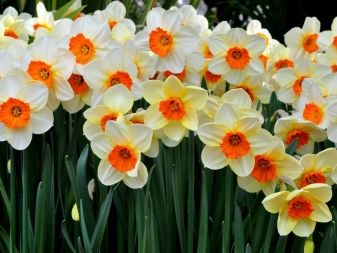
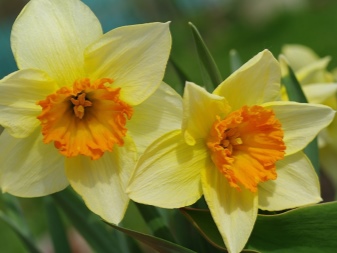
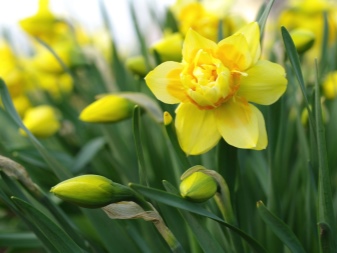
Variety of shades
The flower is a representative of the Amaryllis family from the genus of monocotyledonous bulbous plants. The daffodil bush has many ribbon-shaped leaves, the width of which may vary slightly from species to species. A long stem without leaves (pedicel) can carry one or more inflorescences located at its top.
In addition to wild species, there are many cultivated, bred varieties. First of all, daffodils differ in the color of their inflorescences.
White daffodils
The birthplace of this plant is the Iberian Peninsula, where the flower grows on the mountain slopes. Cultural breeding of this species began at the end of the 16th century. The white daffodil has completely pure white inflorescences, including the inner crown. The height of the bush can reach 35 cm, and the length of the pedicel is about 25 cm. The plant has thin numerous leaves of rich green color. The plant propagates, like all daffodils, by spherical bulbs that are small in size (about 4 cm).
Active growth occurs in mid-spring, and flowering occurs at the end of May and does not last long - only 10 days.


Yellow daffodil
False narcissus is another name for it. In the wild, it grows in European countries - France, Germany and southern Italy. The culture is quite old: it has been grown in garden floriculture since the beginning of the 16th century. This species is distinguished by its small size - the maximum height is 30 cm.The pedicel has only one inflorescence, the size of which is about 4 cm.The flowers rise about 10 cm above the thin leaves of dark green color. ) with uneven wavy edges. The yellow daffodil begins to bloom in mid-May, the flowering duration is about 2 weeks. Small bulbs (up to 4 cm) have a round shape in the form of a ball.
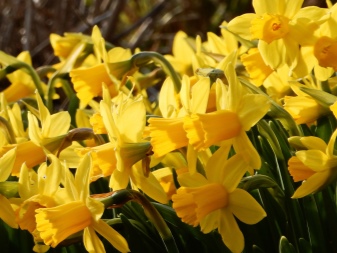
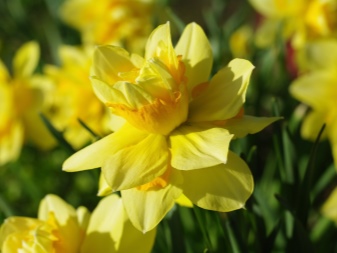
Daffodils pink
This species is widespread in the western regions of Italy, from where it was introduced to France in the 16th century. The plant is tall, it can grow up to 45 cm or more, which is its characteristic difference from other species. The deep green leaves are also slightly wider (about half a centimeter) than other daffodils. The color of the inflorescence has a feature uncharacteristic for daffodils: the crown is painted in a delicate pink color and is framed by snow-white perianth petals.
The peduncle bears only one bud, which blooms in early May. The size of the bulbs is quite large - about 5 cm.
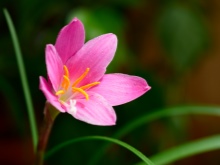
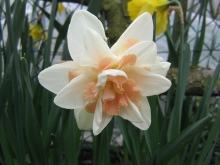
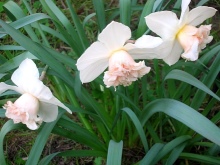
Group overview
The inflorescence of the daffodil has the form of a tubular funnel (bell), whole or consisting of separate fragments, the base of which is bordered by the perianth in the form of straightened petals. Depending on the shape of the flower and its color, plant species are divided into such groups (classes).
Tubular. This group is characterized by the presence of only one bud on the stem, the length of which can be from 15 to 45 cm. The crown, which looks like a long tube, corresponds to or slightly exceeds the length of the perianth.Inflorescences can be monotonously white, yellow or have a two-color color: the perianth and the perianth are colored differently. Daffodils of this group are distinguished by early flowering.
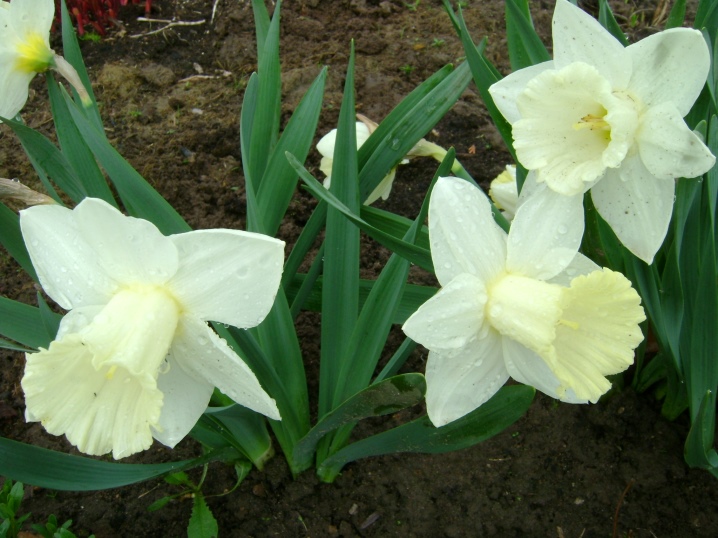
Large-crowned. A characteristic feature of this group is that the length of the crown is 3 times less than the size of the perianth petals. The crown can be wavy or smooth. These daffodils are distinguished by a two-tone color of inflorescences, which has a wide variety of color combinations: the lower perianth petals are white, cream, yellow, and the crown is white or cream, yellow, orange or pink with a brighter border along the edge, which can be corrugated and slightly bent.
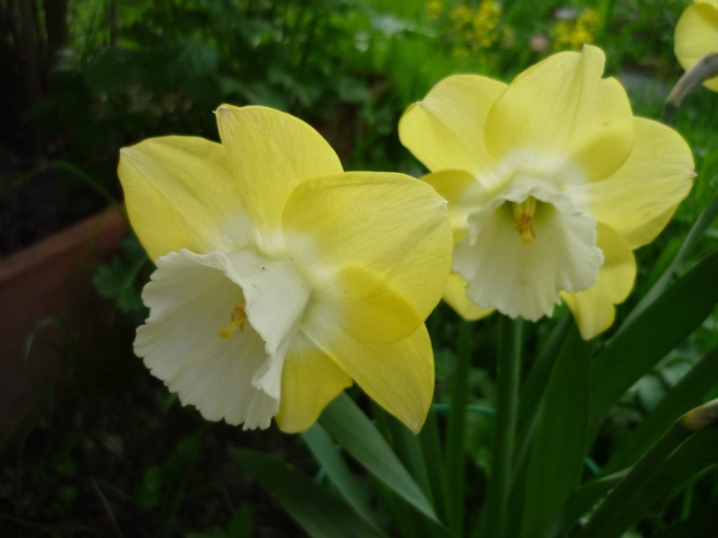
- Small-crowned. The name of this group reflects a characteristic feature of plants: the size of the perianth is small and does not even reach a third of the length of the perianth. The peduncle has a single bud. The lower petals are white, yellow, creamy. The color of the crown is most often peach, yellow or orange, pink and even with a red tint. Often a rim of a more saturated tone runs along the edge. Bloom later, but bloom profusely.
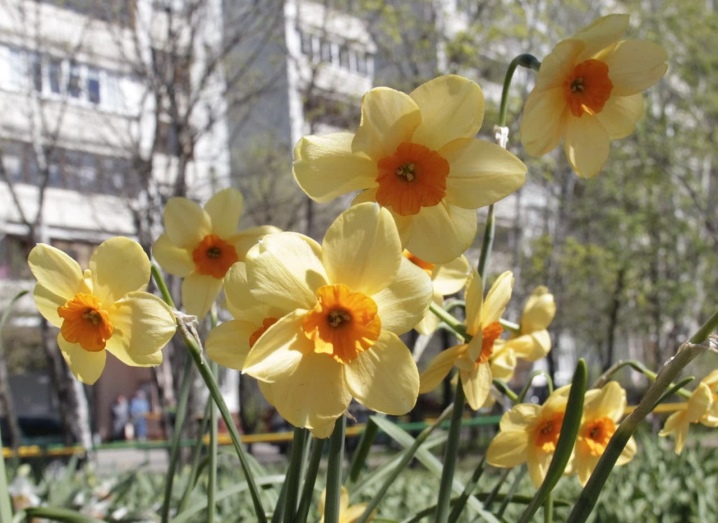
- Terry. These daffodils are completely different from the classic plant species. The stem can bear not one, but several buds. The perianth, the crown, and even a combination of these two options can be terry. Flowers are monochromatic (white, yellow) and two-colored (white with a reddish crown). The peduncle often does not withstand terry caps, especially those that have become heavy after rain, and breaks off. This is considered a disadvantage of this type.
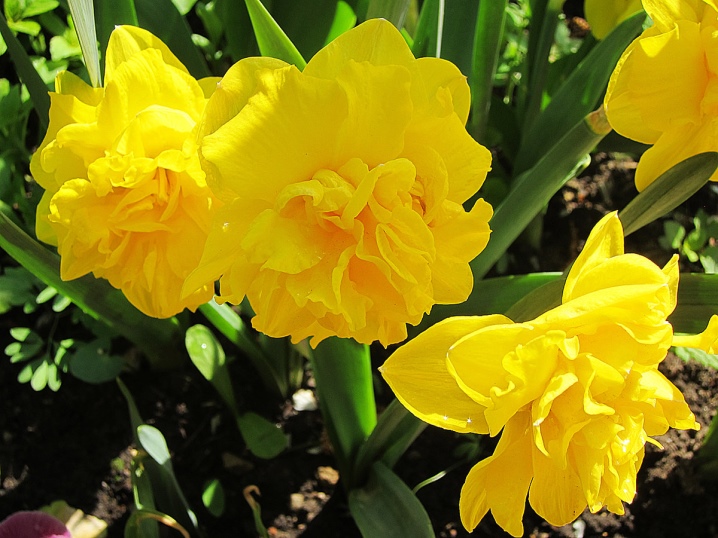
Triandrus. Plants are distinguished by a low peduncle (about 25 cm), bearing 2 or more inflorescences, which are omitted. The lower petals at the base of the crown are slightly bent back. Flowers are most often painted in white, yellow, golden tones.
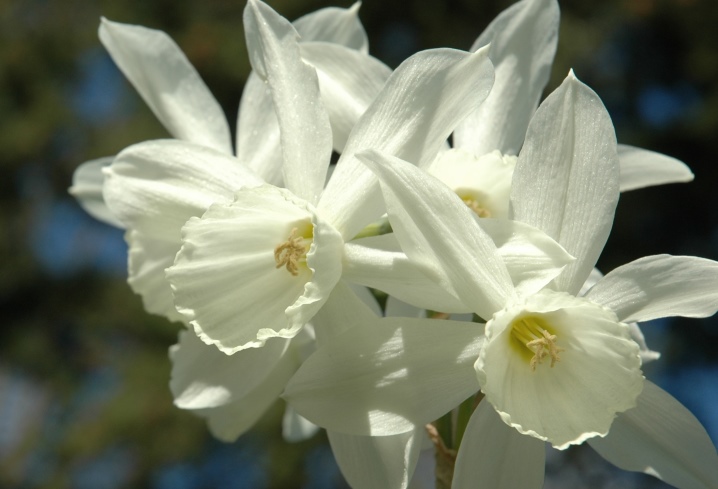
- Cyclameniform. The name itself speaks of its unusual appearance for a narcissist - on a short (15-25 cm) peduncle there is one inflorescence, with a long and narrow crown drooping down. Perianth petals at its base are strongly bent back. They can have one or two colors. The main shades are white, yellow, orange.
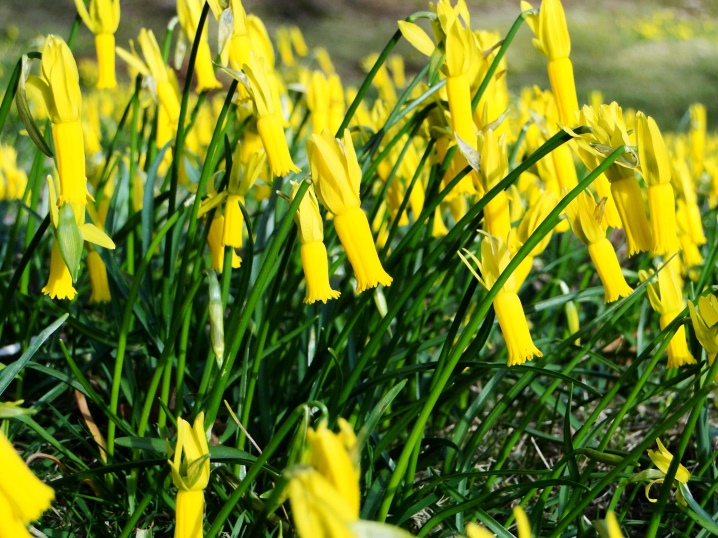
- Jonquilliae. The relatively short pedicel has 2 to 6 small flowers. These daffodils are distinguished by the rounded shape of the lower petals, which are slightly bent back. The crown also has a somewhat peculiar appearance - a small and short, but wide bowl. Inflorescences are usually yellow or white.
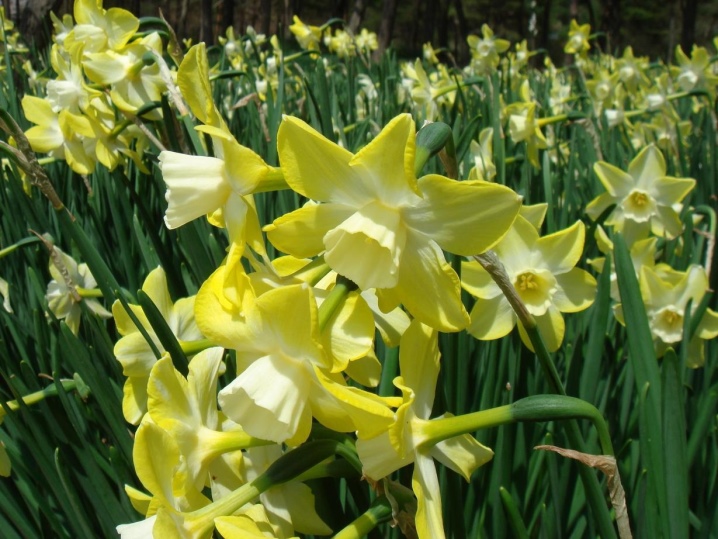
Tacetate. In daffodils of this type, a peduncle with a length of 15 to 45 cm has several buds (from 2 to 8). The open petals with a wavy surface have a rounded shape, and the short crown has a glass shape. The leaves of the bush are wide, dark green. The flowers themselves are painted in white, cream, yellow tones.
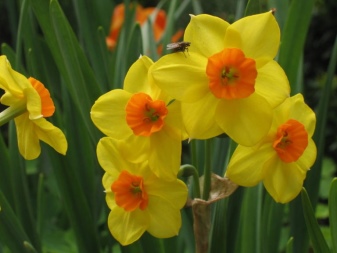
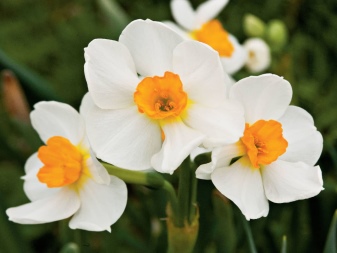
Poetic. This group is widespread on the Mediterranean coast. Plants are tall, reaching 50 cm. One bush can have up to 5 long leaves of a bright green hue. Pedicel is higher than the leaves. On the peduncle, one white flower blooms with an internal disc-shaped, yellow flower. Its middle can be greenish, turning into a bright yellow shade with a reddish rim along the edge. The inflorescence heads are directed downward. The size of the flower in the phase of full disclosure is about 6 cm. It blooms in May for 12 days.

- Split-crown. The peculiarity of this group of daffodils is that the crown is not one-piece, but is divided into separate fragments with a fringed edge. There is only 1 inflorescence on the peduncle. There are two subspecies: split-corona (the lobes of the perianth are located above and adjacent to the perianth petals), papillon (the shape of the flower looks like a butterfly). The tube comes in a variety of colors - white, red and pink, yellow and orange.
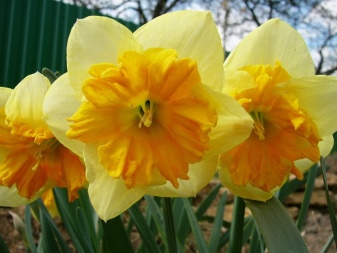
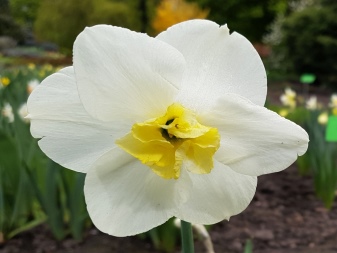
Hybrid (N. Bulbocodium). Plants of this class have a low stem (up to 15 cm in total) with one inflorescence. The narrow perianth petals are underdeveloped and very small. The crown in the inflorescence, on the contrary, is large, wide open and has a peculiar shape of a crinoline skirt.
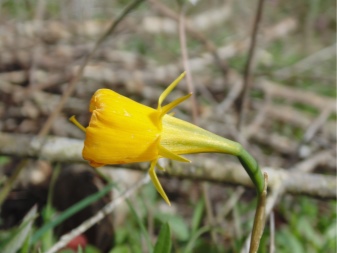

Of course, there are other, less common types that are not included in the groups listed above. Besides, there are wild species of daffodils and their hybrids obtained naturally in natural conditions... In our country, such flowers are grown extremely rarely because they cannot stand the harsh climatic conditions.
Description of popular varieties
There are about 60 species of daffodils in nature. Breeding work with this flower has been going on since the 18th century, and as a result, a huge number of varieties appeared, which number in several thousand. There are also a lot of the most popular and beautiful varieties, including such.
Cool flame. This variety belongs to the group of large-crowned daffodils. The inflorescence is two-color: the crown, painted in a deep orange shade, sometimes turning into a coral one, stands out brightly against the background of snow-white lower petals. The crown has a characteristic highly wavy edge. The height of the bush reaches 40-45 cm, the size of the flower is 10 cm.
Flowering occurs in April or May. The plant is unpretentious and grows well both in sunny and shaded places.
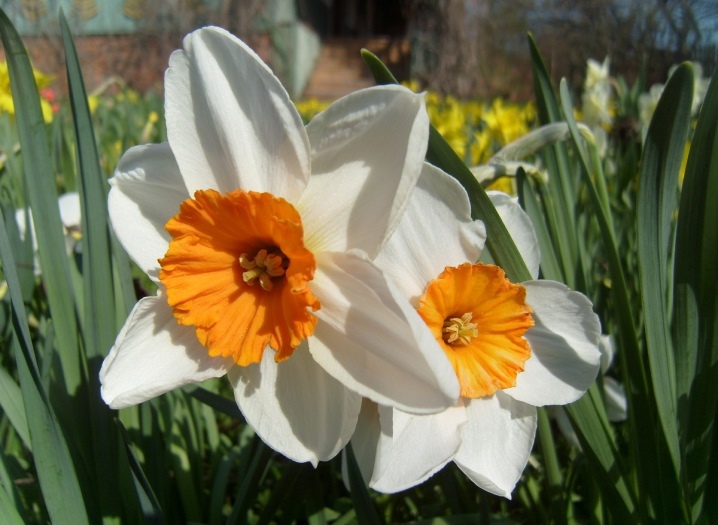
Rip van Winkle variety - a representative of the terry group. The bushes of the plant are low, growing on average up to 30 cm, and the wide leaves are slightly lower than the flower on the peduncle. Both the lower petals and the tube are terry. Strong doubleness is created due to the large number of petals with different directions of growth. Only one flower blooms on the peduncle, which is painted in a thick yellow shade. In the open field, it is grown both in illuminated areas and in the shade.
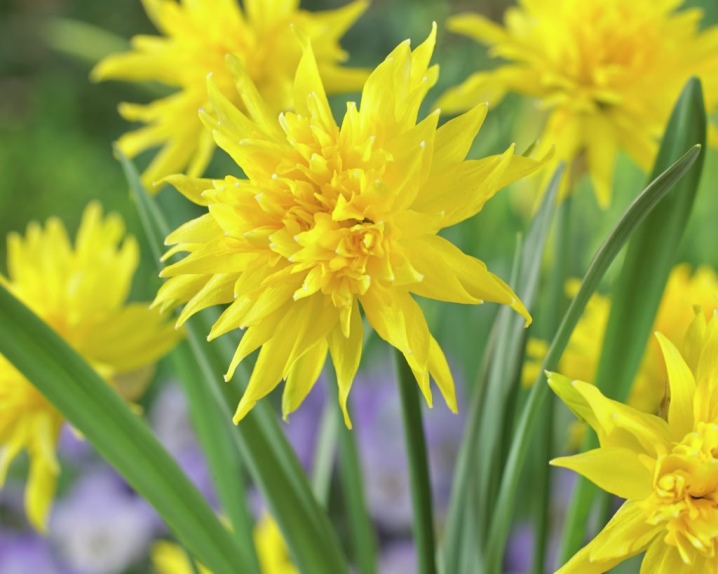
- Narcissus "Bridal crown". Each perianth petal of this variety is elliptical and has a snow-white or cream color. The stem can have up to 4 buds, which, after full disclosure, turn into dense double flowers with soft creamy lower petals and a yellow crown in the center. The tube has a corrugated edge. Plant height - from 30 to 45 cm, medium-sized inflorescences - up to 4 cm in diameter. Flowering occurs in mid-May.

- "Dick Wilden" Is a large-flowered terry variety, a feature of which is very early flowering - already in March. The height of the bush is about 50 cm, and the inflorescences reach a size of 15 cm. The wide (up to 8 cm) lower petals are oval in shape and painted yellow with a greenish tint. In the center of the inflorescence there is a densely-double, fluffy, dark yellow tint.
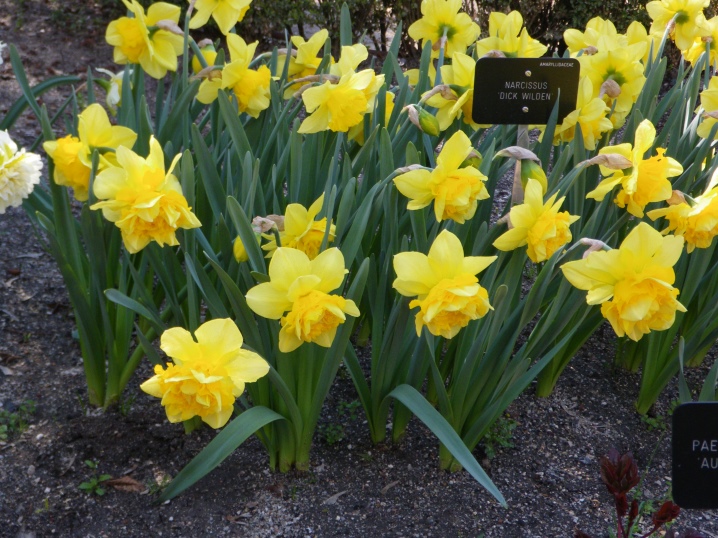
- Rosie Cloud variety - pink terry daffodil group. Even among other terry cloths, it stands out for its beauty and atypicality. The lower petals are pearl pink and frame the luxurious crown. Terry crown of delicate pink color is formed by tightly sitting petals, which amaze with their lightness and airiness, justifying their name - "Pink Clouds". The size of the inflorescence is 5-7 cm, and its color can change its saturation in accordance with the weather. Blooms profusely for 7-10 days.
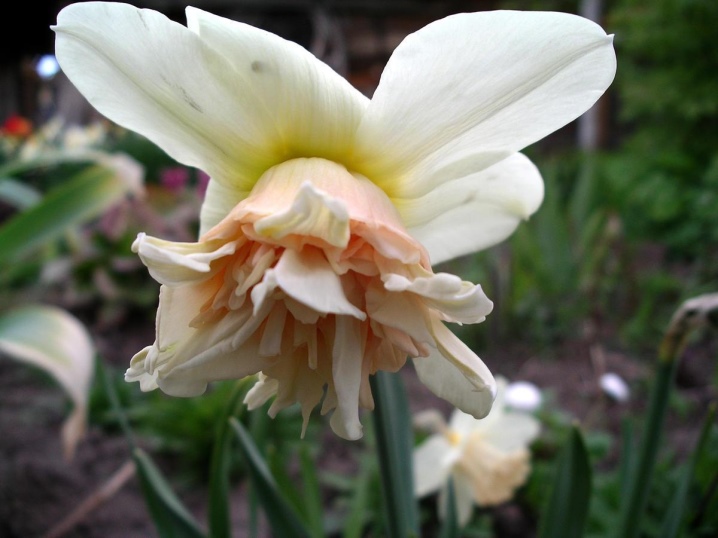
- Artik Bells. The variety belongs to the Bulbocodium hybrid group. They are distinguished by early and abundant flowering. The height of the bush is up to 20 cm. The stem is 25 cm high and carries only one flower, which rises above the leaves. The narrow and small greenish petals of the perianth are bent back. The large crown has a conical (crinoline-like) shape and its size is much larger than the lower petals. The color of the crown is white or ivory.
The leaves of the bush are very thin, almost threadlike, rich green color. One bulb can produce several flower stalks with buds. Blooms in April and May.

- "Albus plenus odoratus". This variety of daffodils is the latest: its flowering occurs in the last decade of May - early June. In its appearance, it bears little resemblance to the classic daffodil: its light corrugated petals grow in several rows, and there is no clearly defined crown. But even the small and neat middle stands out with its bright yellow color.
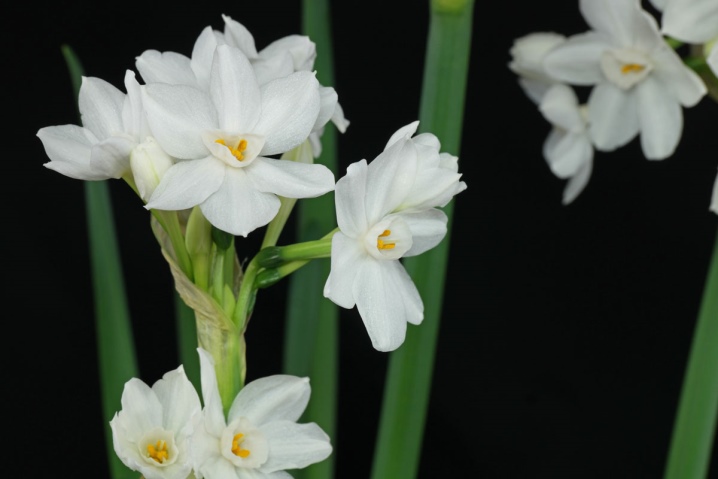
- Calgary Is a variety of white terry daffodils. Terry balls of inflorescences are very similar to small peonies. The peduncle grows up to 40 cm and bears 2 buds. The flower, about 10 cm in size, has many bright white petals with a barely noticeable greenish tinge. The yellow stamens, located in the very center of the lush ball, seem to glow with a golden light. The bush has narrow lanceolate green leaves with a bluish tint.
Flowering occurs in May for 10 days. Not capricious in growing, but prefers open, lit areas.
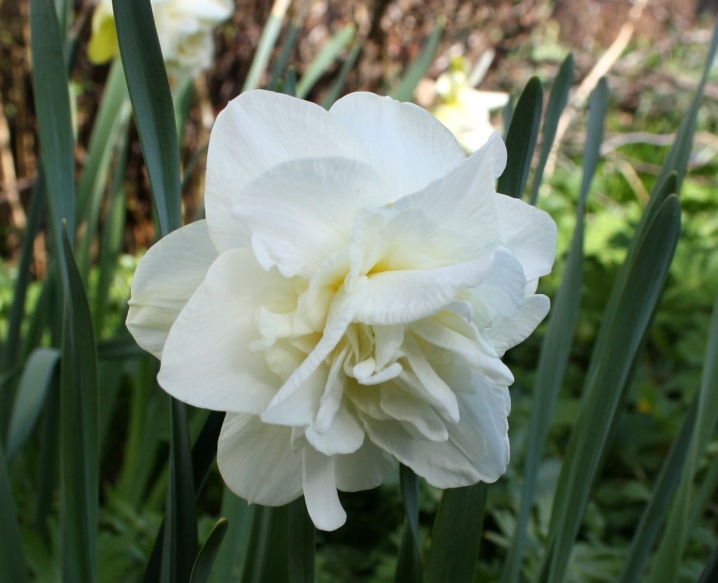
- "Delnasho" - double-colored terry variety. The plant has unusually beautiful flowers with delicate airy petals. There is only 1 inflorescence on the peduncle, but it is quite large (up to 15 cm) with large snow-white rounded petals that border a lush pink-peach center. Petals (white perianth and creamy pink multi-tiered crowns), alternating, gently set off each other. Blooms in May for a long time, almost 2 weeks. The rich color remains until the end of flowering.
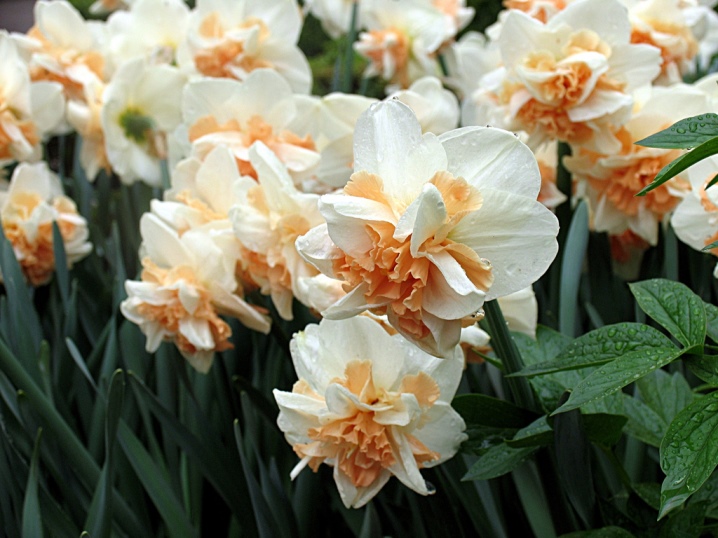
- Sunny Girlfriend variety - among relatively new varieties, it is already quite popular. Narcissus belongs to the split-crown group. It differs from other varieties of this class in that its crown is cut to the very base. A well-opened crown with a yellow center is colored in delicate pink-orange tones. Openwork-wavy edges have a more intense color. The lower petals are white, somewhat longer than the crown. The daffodil "Electrus" also belongs to this group. Its coral crown is fully extended down to the white perianth, and each piece of the crown rests on the lower petals.
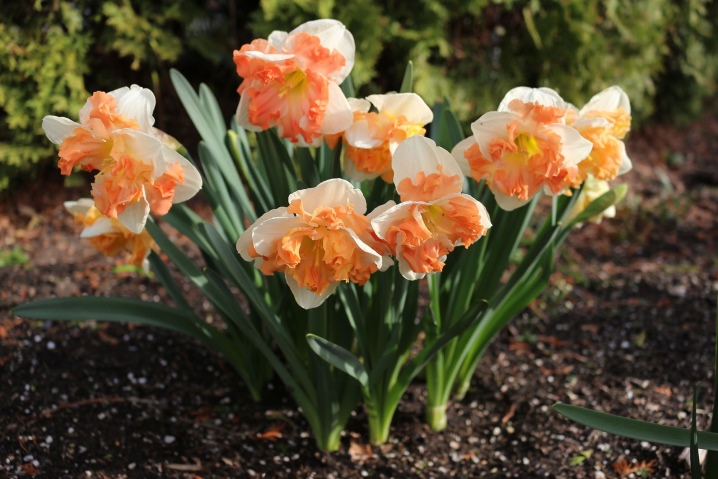
- Cum laude - a variety of pink daffodils. The plant reaches a height of 45 cm. The extraordinary beauty of the inflorescence is created due to the spectacular combination of a pink crown with white petals at its base, which seem to intertwine with each other. The light yellow color of the middle of the tube gradually turns into a creamy pink, which becomes more saturated at the edge. The variety is characterized by high resistance to frost.
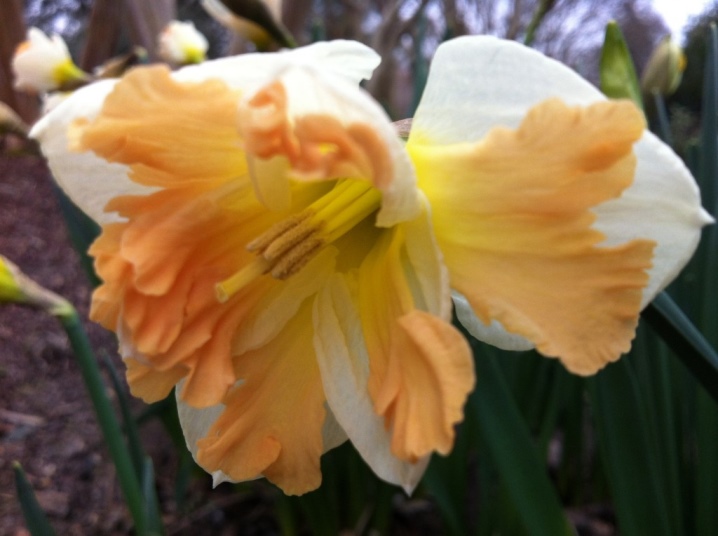
- "Pride of Lions" - a large-crowned daffodil with a bush height of about 45 cm and a flower of about 10-12 cm. The large inflorescence has lemon-yellow lower petals and a bright orange crown with a red rim at the base. It is well opened and looks like a cup. The openwork edges at the crown are evenly corrugated. It should be noted that all varieties of daffodils have a delicate delicate aroma.

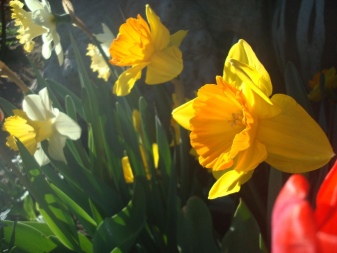
Selection Tips
Narcissus is considered one of the most unpretentious flowers that adapts easily to any conditions. With a huge variety of species and varieties, it is often difficult to make a decision when choosing. It must be remembered that the plant does not bloom for long. This process can be extended by planting daffodils with different flowering periods, and then they will decorate the flower garden from March to May. Blooming daffodils of several varieties of various colors and shapes at the same time look especially impressive. Professionals advise the novice gardener to grow one proven variety first before gaining experience.
When choosing, you must also take into account the combination of daffodil with other flowers growing in the flower bed. They can be planted, and they will look great next to hyacinths, crocuses, but their neighborhood with tulips is especially impressive.
If there are low flowers in the flower garden, such as viola, you can safely choose different varieties: they will be harmoniously combined.
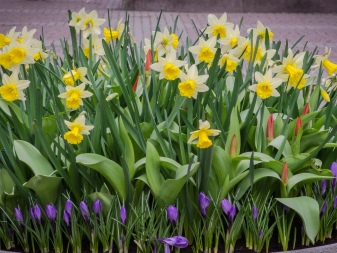
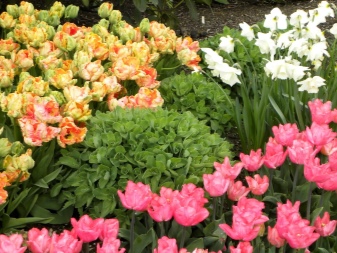
To decorate flower beds with tulips and mixed lawns, varieties of yellow are chosen, and for alpine slides - cyclamen-shaped daffodils.Their pink types will look original in any composition. Borders are decorated with large-crown varieties. Terry varieties can even be grown at home. Narcissus can be considered a versatile flower, since all its varieties and types are great for decorating lawns, flower beds and lawns.
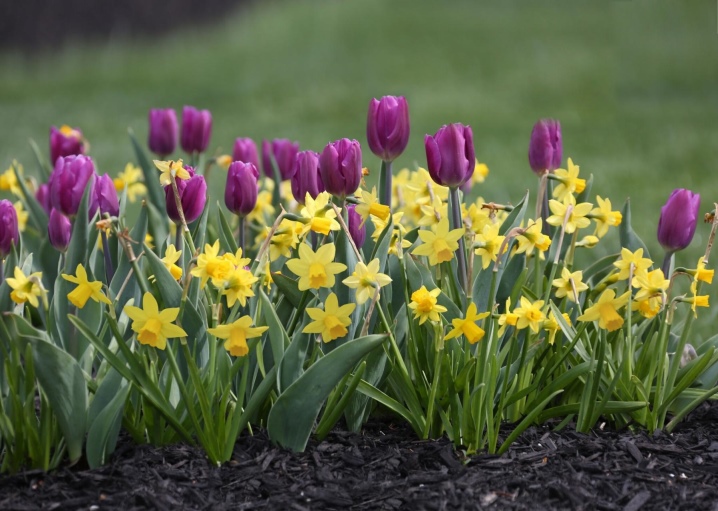
For planting and caring for daffodils, see the next video.






































































































The comment was sent successfully.